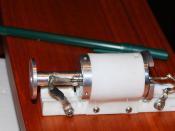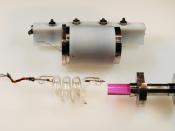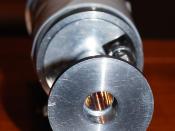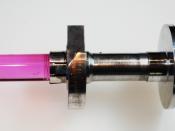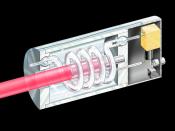Lasers of the 60's
What is Hotter than the sun, finer than a needle, that pierces diamonds, repairs eyes and kills cancers. Give up it is a laser. Although in sci-fi movies they are used as weapons they are used for good. My research essay is on lasers. Lasers are important because lasers help in the medical field. It helps with therapy. It also helps with hair removal. According to nobelprize.org Townes, Basov and Prokhorov shared the prize for their fundamental work, which led to the construction of lasers. They founded the theory of lasers and described how a laser could be built, originating from a similar appliance for microwaves called the MASER that was introduced during the '50s (The MASER has not been used as much as the laser).However, the first functioning laser was not built by them, but by Maiman in 1960. This was the work that resulted in the big and rather clumsy lasers built in the beginning of the '60s.
Still, their theory for the laser effect is the one that fundamentally describes all lasers. Every time you listen to a CD or point with a laser pointer, you hold their discovery in your hand.
The first operating laser was the ruby laser it was made in 1960. It was a ruby laser generating strong pulses of red light. In 1963 Alferov and Kroemer proposed independently of each other, the principle for semiconductor heterostructures to be used later in semiconductor laser which today, by far, is the most common laser. For this work they were awarded the 2000 Nobel Prize in Physics. The advent of the laser, in the sixties, has opened the way to important developments in many fields of physics like atomic and
molecular spectroscopy. The use of several types of lasers, including the dye-lasers, and the possibility of selective excitation of some atomic states allow to consider many new or unresolved problems.
According to the Saturday evening post Bell Telephone Laboratories and R.C.A., were trying to build lasers, using various materials that showed some promise of working. Only a scattered few were trying it with ruby crystals. There were a dozen excellent reasons why you couldn't possibly create a laser out of a ruby. But Dr. Ted Maiman was sure his odd little device was just on the threshold of working. One day. about a week after the skeptical scientists' visit, he got his chance to prove it. A package arrived containing three new ruby crystals- more carefully fabricated, ground and polished than any he'd used before. He incorporated one in his gadgets. On July 15, I960, he and a young lab assistant made a few last adjustments. Maiman threw a switch, and a beam of brilliant red light shot from the end of the ruby-a beam thousands of times more intense
than sunlight, a red of shining purity, more red and more pure than the human
eye had ever seen before. In the silence of the big empty laboratory Doctor Maiman turned and looked at his assistant. "It lased," he said. Thus Dr. Ted Maiman became not only the first man to build a working laser but also, as far as anybody knows, the first
man to use the verb "to lase."
Although Einstein predicted the phenomena called LASER in 1924, the first working laser was built by Theodore H. Maiman of Hughes Aircraft in 1960 when he mounted a specially prepared synthetic ruby rod inside a powerful flash lamp. The flash lamp was needed for the population inversion and the ruby rod which was coated with a reflecting film on both ends was the lasing medium.(T. H. Maiman, "Stimulated Optical Radiation in Ruby", Nature, 6 Aug. 1960, vol. 187, no. 4736, pgs. 493-4). According to ealaser.nl in the sixties and seventies the laser had no real application yet, so the technical value of it was very underestimated. Because of the high energy density of a laser beam it spoke to the people's imagination, resulting in many science fiction movies where aliens and robots were shooting with laser guns and explosions of whole planets with a single laser (Hollywood wanted to make the audience to believe that a laser makes a sound like "psieeeuuw"). Almost everybody knows the famous James Bond scene were 007 is scared for his life because he's tied to a table with a red 10mW (!) HeNe laser aimed at his body.
As the information age was approaching in the eighties, laser made an enormous leap forward and commercial laser applications were developed in a rapid way. The compact disc player and laser printer are the most famous ones but don't forget all the optic fibers used in high speed communication links. Lasers also found their way in chirurgical and other medical applications. Most high power lasers (YAG and CO2) are used precisely controlled cutting, engraving and welding processes in the material processing industry. With the use of a laser beam it is possible to perform very accurate measurements of distance and speed of an (moving) object. This is why the police departments use their "famous" laser guns to measure the speed of a vehicle. Lasers are also applied in the Semiconductor (Integrated Circuit) production processes because of their outstanding accurate optic performance. Other applications are: leveling, barcode scanning, targeting (guns), laser guided weapons etc. etc. In the creative region lasers are used for the exposure process when making holograms. Almost all movies shown in cinemas have laser-drawn subtitles
According to printerworks.com Xerox started work on laser printers back in 1969.
According to The University of Chicago Press When the first working laser was reported in 1960, it was described as "a solution looking for a problem." But before long the laser's distinctive qualities-its ability to generate an intense, very narrow beam of light of a single wavelength-were being harnessed for science, technology and medicine. Today, lasers are everywhere: from research laboratories at the cutting edge of quantum physics to medical clinics, supermarket checkouts and the telephone network.
Theodore Maiman made the first laser operate on 16 May 1960 at the Hughes Research Laboratory in California, by shining a high-power flash lamp on a ruby rod with silver-coated surfaces. He promptly submitted a short report of the work to the journal Physical Review Letters, but the editors turned it down. Some have thought this was because the Physical Review had announced that it was receiving too many papers on masers-the longer-wavelength predecessors of the laser-and had announced that any further papers would be turned down. But Simon Pasternack, who was an editor of Physical Review Letters at the time, has said that he turned down this historic paper because Maiman had just published, in June 1960, an article on the excitation of ruby with light, with an examination of the relaxation times between quantum states, and that the new work seemed to be simply more of the same.
with official publication of Maiman's first laser under way, the Hughes Research Laboratory made the first public announcement to the news media on 7 July 1960. This created quite a stir, with front-page newspaper discussions of possible death rays, but also some skepticism among scientists, who were not yet able to see the careful and logically complete Nature paper. Another source of doubt came from the fact that Maiman did not report having seen a bright beam of light, which was the expected characteristic of a laser.
Works Cited
"The first laser." University of Chicago Press, Books. 28 Mar. 2009 <http://www.press.uchicago.edu/Misc/Chicago/284158_townes.html>.
Gunttier, Max. "THE ASTOUNDING LASER." 24 Oct. 1964. Ebsco. 28 Mar. 2009 <http://web.ebscohost.com/ehost/pdf?vid=2&hid=17&sid=72cb9273-e8ac-4027-a29a-5f3bc1cb6a02%40SRCSM1>.
IPNAS université de Liège Belgium. 27 Mar. 2009 <http://www.ipnas.ulg.ac.be/laboipnas/folders/LaserSfolder.pdf>.
"Laser." E&A Laser. 28 Mar. 2009 <http://www.ealaser.nl/laser.htm>.
"Laser Facts." Nobelprize.org. 27 Mar. 2009 <http://nobelprize.org/educational_games/physics/laser/facts/applications.html>.
